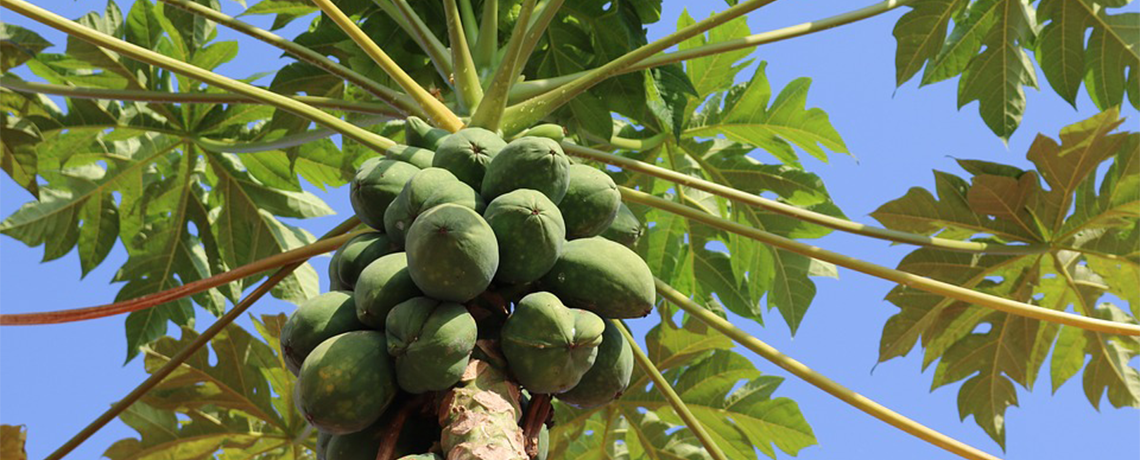Papaya Genetically Engineered to Resist Viral Infection Fails Against New Virus Lineage

Breakdown of virus resistance in GM papaya raises big questions about the sustainability of GM virus resistance more generally, even when initially successful
Dr Doug Gurian-Sherman, agriculture science and policy consultant at Strategic Expansion and Trainings LLC, commented on the recent paper reporting that virus resistance in China’s GM papaya has broken down:
There are a couple important takeaways from this paper.
Although no one should be surprised, this confirms that resistance by pathogens can occur to engineered virus resistance. Gene silencing through RNA is a natural mechanism, modified by GE to engineer resistance in crops, and so pest organisms should be able to adapt (become resistant) by modifying these mechanisms. This occurred naturally in plants and plant viruses before GE.
Once (or if) other RNA based products, like Monsanto/Bayer’s important RNAi rootworm product are introduced, I expect that resistance by rootworm will also occur pretty quickly. Although their genetics and molecular biology differ from that of plant viruses, insects also have have regulatory RNA mechanisms with some similarities to silencing. Also, the rootworm product does not provide a high dose, which is important for resistance management by refuge. I mention this because rootworm is such an important pest of corn in the U.S., and its success or failure, once commercialized, could be another important example of GE failure if resistance occurs relatively quickly.
Another important aspect to this is the genetic diversity of the virus and the widespread planting of the GE crop in China. The Hawaiian GE papaya has not lost efficacy (yet) to resistant virus evolution. But that may well be an anomaly due to the relatively lower diversity of the Hawaiian strains, and the lower acreage of GE papaya there. High genetic diversity (which is common for natural populations) facilitates resistance development. The situation in Hawaii is not a typical situation for viruses or many other pathogens generally, outside of islands.
In the earlier days of GE (e.g. 10 to 20 years ago), I thought that virus resistance might be one of the easier and more reliable types of engineered crops, and there are a few other examples that have not been widely commercialized (e.g. squash and plums). I thought that by now, we might have many more. One reason that there has not been more may be because when there are several different strains, as was the case apparently for GE sweet potato feathery mottle virus failure years ago, it is harder to engineer effective resistance.
But the resistance seen in China, beginning, it seems, in a relatively short period of time, raises big questions about the sustainability of GE virus resistance more generally, even when initially successful.
Dr. Gurian-Sherman’s quotes were originally published at GMWatch.org.
About the report:
Ringspot virus-resistant GM papayas are often cited as a genetic engineering success. But a new study (abstract below) reports that in China, the virus resistance in GM papaya has broken down under pressure from a new lineage of the virus.
The study reports that the GM virus-resistant papaya planted in Hawaii retains its virus resistance. But this has not saved the Hawaiian papaya industry, since many countries don’t want GM papaya and up to a third of the crop is thrown away because it’s bruised or mis-shapen. As a result, USDA scientists have been looking at ways to make the unwanted GM papayas into biofuel.
In addition, a non-GM virus-resistant papaya has been developed, suggesting that the GM version is not needed.
—
Read the full report:
Characterization of Papaya ringspot virus isolates infecting transgenic papaya ‘Huanong No. 1’ in South China
Wu, Z., Mo, C., Zhang, S., & Li, H. (2018). Scientific Reports, 8(1), 8206.
https://www.nature.com/articles/s41598-018-26596-x
Abstract
In 2006, the release and cultivation of the genetically modified papaya cultivar ‘Huanong No.1’ successfully controlled the destructive papaya ringspot disease caused by Papaya ringspot virus (PRSV) in South China. However, some transgenic papaya plants from Guangdong and Hainan are found infected by PRSV. In this study, Field investigation was carried out and susceptible transgenic papaya samples were collected during 2012–2016.
Twenty representative isolates were artificially inoculated into Cucurbita pepo and commercialised ‘Huanong No.1’ papaya, and results indicated that the plants showed obvious disease symptoms. Phylogenetic analysis of CP genes of 120 PRSV-infected isolates showed that PRSV can be divided into three groups. Isolates from Guangdong and Hainan belong to Group III, which is further divided into two subgroups. The isolates collected in this study have greatly diverged from the previously reported dominant strains Ys, Vb and Sm in South China, indicating that they belong to a new lineage.
Further analysis showed a highly genetic differentiation between isolates, and 27.1% of the isolates were identified as recombinants on the basis of CP nucleotide sequences. These results indicate that the genetic variation of PRSV and the formation of the new virus lineage may explain the loss of transgenic papaya resistance in South China.
